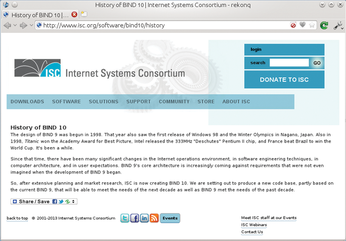Exploring the new Bind 10 name server
The Bind name server has a mixed reputation. Although the lion's share of DNS servers on the web run it, veteran administrators will recall – with a mixture of melancholy and horror – the difficult transition from Bind 4 to Bind 8: Although the zone files were almost identical, the configuration moved from named.boot to named.conf. The format suddenly contained brackets and semicolons that were once unnecessary. Additionally, Bind 8 and its successor allowed more configuration options, for which the old format proved insufficient.
After five years of development (Figure 1), Bind 10 brings even greater upheaval. Not only the configuration, but also the architecture has changed fundamentally. JSON database files replace named.conf; zones are still configured with familiar zone files, but in operation they are also stored in SQLite. (The administrator has the option to disable the default database storage option and go back to storage in normal zone files.)

[...]
Buy this article as PDF
(incl. VAT)
